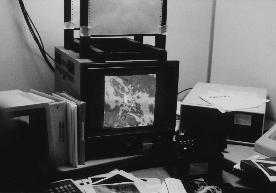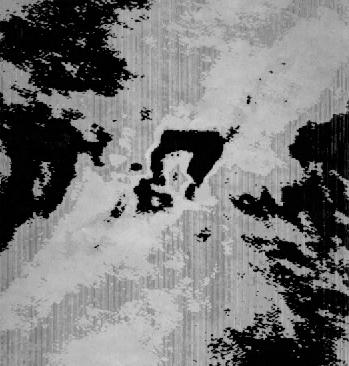Our Galaxy's Black Heart
Jack Kramer
A conviction has been building over the past twenty years that the Milky Way galaxy harbors a supermassive black hole at its center. Now it seems almost certain. Proof has been elusive because our galaxy's core is obscured by a thick blanket of interstellar dust, which makes visible-light studies impossible. However, radio observations have revealed an unusual source, dubbed Sagittarius A* (pronounced "A star"), and infrared surveys show it to be surrounded by a dense cluster of stars. Astronomers have recently shown that those stars are moving exactly as expected if they were under the influence of an unseen central mass of 2.6 million Suns. They used a powerful infrared camera and the 10-meter Keck telescope on Mauna Kea to probe the central star cluster with unprecedented resolution. The stars could be seen changing position from year to year at inferred velocities up to 1,400 kilometers per second. That only makes sense if they're being whipped around by the immense gravity of a black hole.
The confirmation of this black hole became more tangible as I was looking through some old photographs taken during previous LCAS trips to New Mexico. On the first trip there in 1986, we enjoyed a tour of the VLA radio telescope facility, located on the high Plains of St. Augustin. At the very time of our visit, the astronomers there were viewing a just-acquired false-color radio image of the heart of the Milky Way. They pointed out to us where they believed a black hole was lurking, buried in the rich star clouds of Sagittarius. In a rare moment of insight, I snapped the following photo, which shows the monitor displaying that false-color image.

The following is a printed copy of the image from the monitor. The small, irregularly-shaped black spot at center is the telltale mark of the black hole. The image was formed by the radio contours of the Milky Way -- the high-energy radio band output picked up by the array of movable antennas at the VLA. Being visually-oriented, most of us wouldn't be too impressed by a printout of variations in radio emissions or the squiggly traces on a chart recorder. But convert those variations to a contour map that we can see, and it means a lot more.

It would take several years for the evidence of this black hole to accumulate to the point where this assertion has become widely accepted. As I look back at those photos, it's apparent that the five of us LCAS members on that trip, standing there watching the computer monitor at the VLA facility, had unwittingly been eyewitnesses to a piece of scientific history in the making.
Published in the February 1999 issue of the NightTimes




